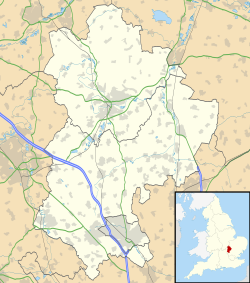
Luton is a town and unitary authority with borough status in Bedfordshire, England, with a population at the 2021 census of 225,262.
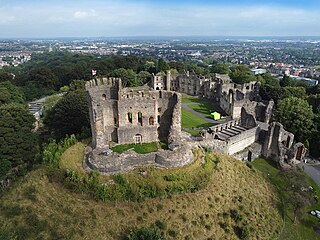
Dudley Castle is a ruined fortification in the town of Dudley, West Midlands, England. Originally a wooden motte and bailey castle built soon after the Norman Conquest, it was rebuilt as a stone fortification during the twelfth century but subsequently demolished on the orders of Henry II of England. Rebuilding of the castle took place from the second half of the thirteenth century and culminated in the construction of a range of buildings within the fortifications by John Dudley. The fortifications were slighted by order of the Parliament of England during the English Civil War and the residential buildings destroyed by fire in 1750. In the nineteenth and early twentieth century the site was used for fêtes and pageants. Today Dudley Zoo is located on its grounds.

Kirby Muxloe Castle, also known historically as Kirby Castle, is a ruined, fortified manor house in Kirby Muxloe, Leicestershire, England. William, Lord Hastings, began work on the castle in 1480, founding it on the site of a pre-existing manor house. William was a favourite of King Edward IV and had prospered considerably during the Wars of the Roses. Work continued quickly until 1483, when William was executed during Richard, Duke of Gloucester's, seizure of the throne. His widow briefly continued the project after his death but efforts then ceased, with the castle remaining largely incomplete. Parts of the castle were inhabited for a period, before falling into ruin during the course of the 17th century. In 1912, the Commissioners of Work took over management of the site, repairing the brickwork and carrying out an archaeological survey. In the 21st century, the castle is controlled by English Heritage and open to visitors.

Hedingham Castle, in the village of Castle Hedingham, Essex, is arguably the best preserved Norman keep in England. The castle fortifications and outbuildings were built around 1100, and the keep around 1140. However, the keep is the only major medieval structure that has survived, albeit less two turrets. It is a Grade I listed building and a scheduled monument. The keep is open to the public.

Baconsthorpe Castle, historically known as Baconsthorpe Hall, is a ruined, fortified manor house near the village of Baconsthorpe, Norfolk, England. It was established in the 15th century on the site of a former manor hall, probably by John Heydon I and his father, William. John was an ambitious lawyer with many enemies and built a tall, fortified house, but his descendants became wealthy sheep farmers, and being less worried about attack, developed the property into a more elegant, courtyard house, complete with a nearby deer park.
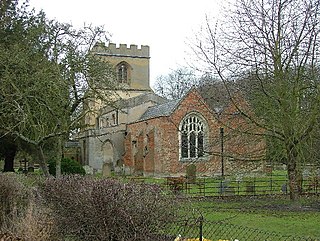
Hexton is a small village and civil parish in Hertfordshire, England, about 6 miles (10 km) west of Hitchin.

A gatehouse is a type of fortified gateway, an entry control point building, enclosing or accompanying a gateway for a town, religious house, castle, manor house, or other fortification building of importance. Gatehouses are typically the most heavily armed section of a fortification, to compensate for being structurally the weakest and the most probable attack point by an enemy. There are numerous surviving examples in France, Austria, Germany, England and Japan.

Bickleigh Castle is a fortified manor house that stands on the banks of the River Exe at Bickleigh in Devon, England. Once considerably larger, Bickleigh now comprises a group of buildings from various periods which together formed a water castle.

Wressle Castle is a ruined palace-fortress in the East Riding of Yorkshire, England, built for Thomas Percy in the 1390s. It is privately owned and it is usually open to the public for a few days each year. Wressle Castle originally consisted of four ranges built around a central courtyard; there was a tower at each corner, and the structure was entered through a gatehouse in the east wall, facing the village.

John Wenlock, 1st Baron Wenlock was an English politician, diplomat, soldier and courtier. He fought on the sides of both the Yorkists and the Lancastrians in the Wars of the Roses. He has been called "the prince of turncoats", although some historians suggest the label may not be fair as this behavior was commonplace during the Wars of the Roses. Others contend that even when Wenlock was not actually changing sides, he was engaged in "fence sitting par excellence."
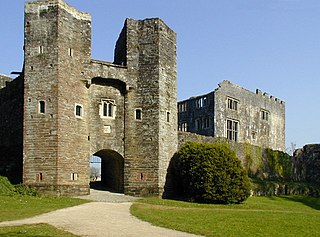
Berry Pomeroy Castle, a Tudor mansion within the walls of an earlier castle, is near the village of Berry Pomeroy, in South Devon, England. It was built in the late 15th century by the Pomeroy family which had held the land since the 11th century. By 1547 the family was in financial difficulties and sold the lands to Edward Seymour, 1st Duke of Somerset. Apart from a short period of forfeit to the Crown after Edward's execution, the castle has remained in the Seymour family ever since, although it was abandoned in the late 17th century when the fourth baronet moved to Wiltshire.

Wardown House Museum and Gallery formerly Wardown Park Museum and, before that, the Luton Museum & Art Gallery in Luton, is housed in a large Victorian mansion in Wardown Park on the outskirts of the town centre. The museum collection focuses on the traditional crafts of Bedfordshire, notably lace-making and hat-making. There are samples of Bedfordshire lace from as early as the 17th century.

St Mary's Church is an Anglican Church in the centre of the town of Luton, England. The church has a rich and long history, being over 900 years old and has been rebuilt and refurbished constantly over the centuries. The Church is one of the largest in Bedfordshire and considered a fine example of medieval architecture. The Church is part of the St Albans Diocese. The church is grade-I listed and the only one to be a grade-I listed building in the whole of Luton.
Luton is a town located in the south of Bedfordshire, England.

Northborough Manor House, also known as Northborough Hall or Northborough Castle Farmhouse, is a medieval fortified manor house, and Grade I listed building in the village of Northborough in Cambridgeshire, England.

Newton St Loe Castle was a fortified manor house in the village of Newton St Loe, Somerset, England. Parts of it survive: a 14th-century keep and 15th-century gatehouse, both Grade I listed buildings.
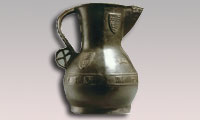
The Wenlok jug or Wenlock jug is a rare surviving example of an English bronze jug from the 15th century, with great significance for the study of bronze working in medieval England. Only two similar jugs are known in the UK. The Wenlok jug is the smallest of the three, but bears the earliest maker's mark for the English founder - possibly a bell founder - who cast it. The other examples are the Asante Ewer, which retains its lid and is held by the British Museum having been found at Kumasi in the Gold Coast in 1896 during the Anglo-Ashanti wars, and the Robinson jug, which was found in a farmhouse in Norfolk in the 1879 and is now in the collection of the Victoria & Albert Museum. All bear inscriptions in English and were made from leaded bronze, an alloy of copper, tin and lead, cast in a two-part mould in a similar manner using bronze spacers to separate the inner and outer moulds, with similar decorative motifs.
Walsall Castle, also known as Walsall Moat, or le Mote during the 1400s, was a 12th or 13th-15th century moated manor house in the market town of Walsall in the West Midlands. The current site of the castle is occupied by a parking lot for the nearby Walsall Manor Hospital and the moat ran along what is now southern Moat Street - despite this, no visible remains exist and all earthworks have been flattened.

